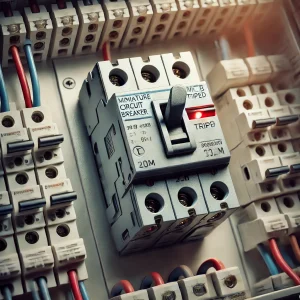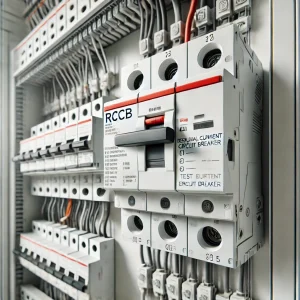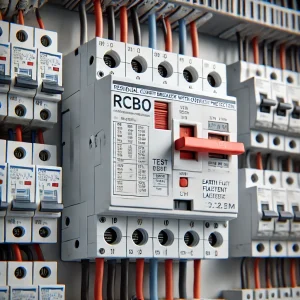Selecting the correct protective equipment is crucial for safety and reliability in the electrical industry. The MCB Circuit Breakers, RCCBs, and RCBOs are some of the many devices used to protect electrical systems from different kinds of faults. Understanding their differences helps in choosing appropriate protection for various applications. This post examines what distinguishes an MCB Circuit Breaker from an RCCB or RCBO, concentrating on its functions, features, and typical uses.
Shop Now
[woo_product_slider id=”23713″]
What is an MCB circuit breaker?

An MCB circuit breaker (miniature circuit breaker) is a switch that protects electric circuits against overloads as well as short circuits. It trips when too much current flows through it, thereby cutting off such a circuit to prevent damage. Due to its compact design, this kind of circuit breaker can be easily fitted into small spaces, making them widely used in residential, commercial, and industrial installations because they are always efficient and reliable.
Key Features of MCB Circuit Breakers:
- Often referred to as mini circuit breakers since they are designed with a compact size.
- There are different types of MCB circuit breakers categorized according to trip curves, like:
- Curve C, which suits general use with standard loads
- B-curve is meant for residential applications with light loads.
- D curves are suitable for motors, among other inductive loads with high inrush currents.
- Provides essential overload protection that prevents electrical fires or equipment damage due to short circuits.
What is an RCCB?

RCCB, known as, safeguards against earth leakage faults and electric shocks by sensing any difference between live and neutral currents passing through it. Unlike MCBs, these devices do not offer protection against overloads or short circuits but are very important in preventing electric shocks, especially where there is high moisture content or where there are more chances of having such faults in electrical installations.
Key features of RCCBs:
- Detects earth fault leakage currents so as to prevent fire accidents and electric shocks.
- Doesn’t protect against overcurrent like MCB circuit breakers do.
- Commonly used in areas with extra moisture levels, such as bathrooms, kitchens, or outdoor locations, where the risk of getting shocked is greater.
What is an RCBO?

Residual Current Circuit Breaker with Overload Protection or RCCB combines the work of an MCB and an RCCB. It provides full coverage protection by guarding against overloads, short circuits, and earth leakages, thus making it a good choice for both residential and commercial installations.
Key features of RCBOs
- They protect against a wide range of electrical faults because they have features similar to MCB circuit breakers and RCCBs.
- Saves space in electrical panels since several protective functions can be integrated into one unit.
- It is best suited for critical circuits requiring both overload protection and earth fault detection, like those found at homes or businesses.
Comparing MCB Circuit Breakers, RCCBs, and RCBOs
Functionality:
- MCB Circuit Breaker: Protects against overloads and short circuits; available types include mini circuit breaker, miniature circuit breaker, curve C circuit breaker, b curve circuit breaker, d curve circuit breaker, etc.
- RCCB focuses on earth fault protection, which is essential for preventing electric shocks.
Applications:
- MCB Circuit Breaker: It is utilized in common electrical systems to provide protection for wiring and devices against overloads and short circuits.
- RCCB is to be used in places with a risk of getting an electric shock, like wet areas, outdoor circuits, etc.
- RCBO: These are ideal for sensitive equipment or high-risk zones where dual protection may be required by the circuit.
Installation Considerations
- MCB Circuit Breaker- The MCB Circuit Breaker should often accompany RCCBs for enhanced protection; this also goes along with compatibility with relay and circuit breaker setups.
- RCCB– In order to ensure complete circuit protection, it must always be used together with an MCB.
- RCBO– They are costlier than others, but they make installations easier by providing combined protections.
The Importance of Choosing the Right Device
Choosing the right protective device is very important for the safety of electrical systems. MCB Circuit Breakers are used universally because they provide defense against overloads and shorts, which makes them best suited for this purpose. RCCBs are necessary where prevention from electric shocks is given priority due to environmental conditions, while RCBOs work best when both functions (MCB and RCCB) need to be implemented within one system because such situations require a more comprehensive approach toward safety measures against any possible hazards that might arise from different causes.
Conclusion
By any of the individuals involved with electrical installations or maintenance, whoever it may be, because this knowledge is equally important to get known. MCB circuit breakers are designed to deliver basic protection against overloads and short circuits, while RCCBs help detect earth faults. An inherently safe alternative is the combined MCB and RCCB, known as an RCBO. The right choice and correct mounting of these devices guarantee protection from electrical system accidents.


